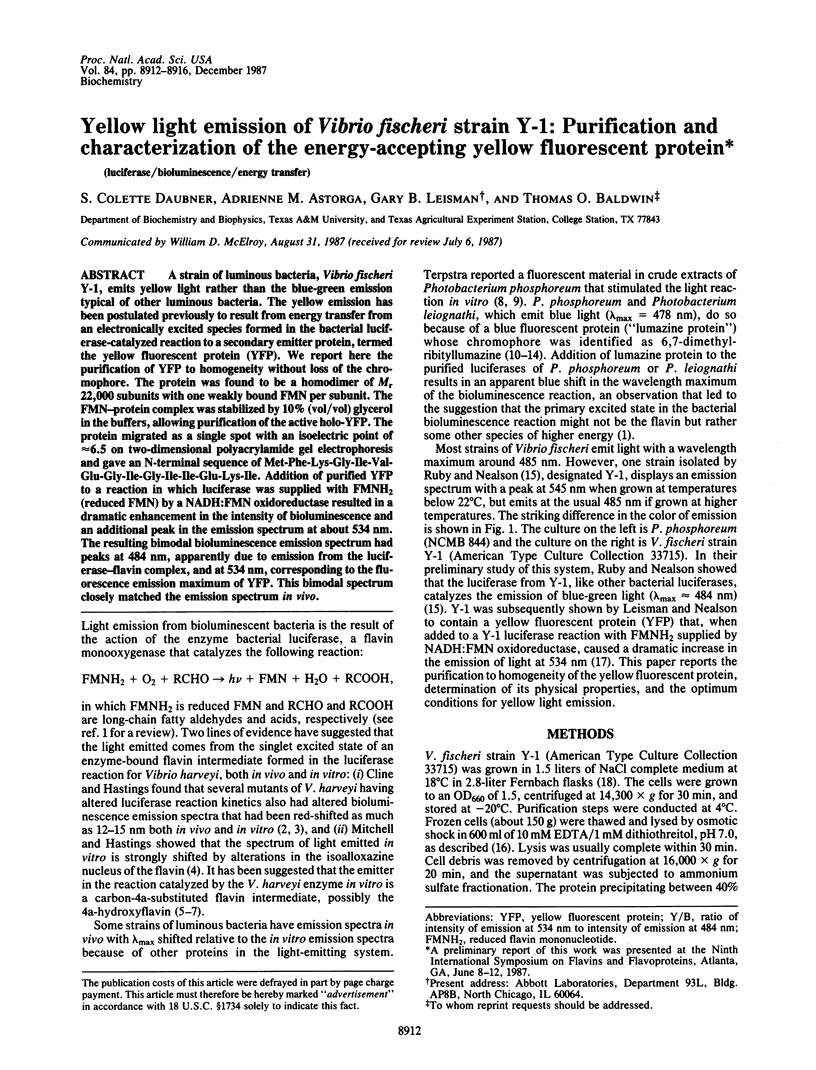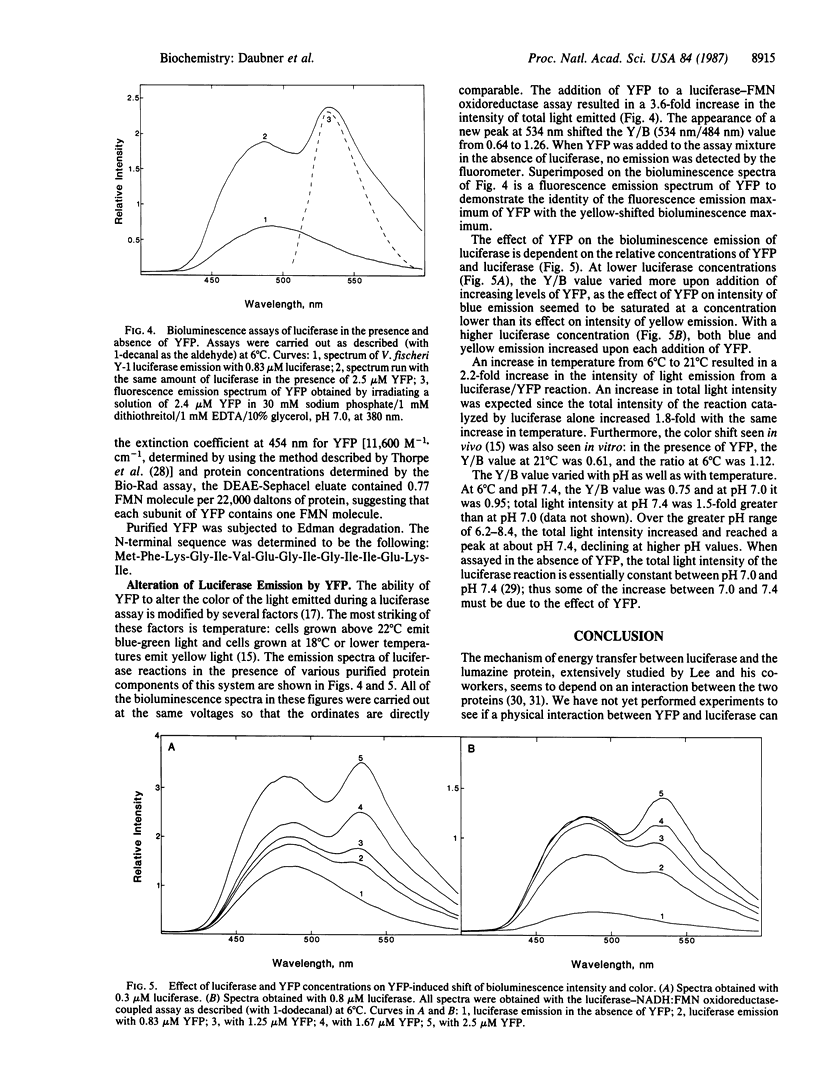Abstract
A strain of luminous bacteria, Vibrio fischeri Y-1, emits yellow light rather than the blue-green emission typical of other luminous bacteria. The yellow emission has been postulated previously to result from energy transfer from an electronically excited species formed in the bacterial luciferase-catalyzed reaction to a secondary emitter protein, termed the yellow fluorescent protein (YFP). We report here the purification of YFP to homogeneity without loss of the chromophore. The protein was found to be a homodimer of Mr 22,000 subunits with one weakly bound FMN per subunit. The FMN-protein complex was stabilized by 10% (vol/vol) glycerol in the buffers, allowing purification of the active holo-YFP. The protein migrated as a single spot with an isoelectric point of approximately 6.5 on two-dimensional polyacrylamide gel electrophoresis and gave an N-terminal sequence of Met-Phe-Lys-Gly-Ile-Val-Glu-Gly-Ile-Gly-Ile-Ile-Glu-Lys-Ile. Addition of purified YFP to a reaction in which luciferase was supplied with FMNH2 (reduced FMN) by a NADH:FMN oxidoreductase resulted in a dramatic enhancement in the intensity of bioluminescence and an additional peak in the emission spectrum at about 534 nm. The resulting bimodal bioluminescence emission spectrum had peaks at 484 nm, apparently due to emission from the luciferase-flavin complex, and at 534 nm, corresponding to the fluorescence emission maximum of YFP. This bimodal spectrum closely matched the emission spectrum in vivo.
Full text
PDF




Images in this article
Selected References
These references are in PubMed. This may not be the complete list of references from this article.
- Cline T. W., Hastings J. W. Mutated luciferases with altered bioluminescence emission spectra. J Biol Chem. 1974 Jul 25;249(14):4668–4669. [PubMed] [Google Scholar]
- Cline T. W., Hastings J. W. Mutationally altered bacterial luciferase. Implications for subunit functions. Biochemistry. 1972 Aug 29;11(18):3359–3370. doi: 10.1021/bi00768a008. [DOI] [PubMed] [Google Scholar]
- Gast R., Lee J. Isolation of the in vivo emitter in bacterial bioluminescence. Proc Natl Acad Sci U S A. 1978 Feb;75(2):833–837. doi: 10.1073/pnas.75.2.833. [DOI] [PMC free article] [PubMed] [Google Scholar]
- Gast R., Neering I. R., Lee J. Separation of a blue fluorescence protein from bacterial luciferase. Biochem Biophys Res Commun. 1978 Jan 13;80(1):14–21. doi: 10.1016/0006-291x(78)91097-5. [DOI] [PubMed] [Google Scholar]
- Hastings J. W., Nealson K. H. Bacterial bioluminescence. Annu Rev Microbiol. 1977;31:549–595. doi: 10.1146/annurev.mi.31.100177.003001. [DOI] [PubMed] [Google Scholar]
- Holzman T. F., Baldwin T. O. Isolation of bacterial luciferases by affinity chromatography on 2,2-diphenylpropylamine-Sepharose: phosphate-mediated binding to an immobilized substrate analogue. Biochemistry. 1982 Nov 23;21(24):6194–6201. doi: 10.1021/bi00267a026. [DOI] [PubMed] [Google Scholar]
- Kurfürst M., Ghisla S., Hastings J. W. Characterization and postulated structure of the primary emitter in the bacterial luciferase reaction. Proc Natl Acad Sci U S A. 1984 May;81(10):2990–2994. doi: 10.1073/pnas.81.10.2990. [DOI] [PMC free article] [PubMed] [Google Scholar]
- LOWRY O. H., ROSEBROUGH N. J., FARR A. L., RANDALL R. J. Protein measurement with the Folin phenol reagent. J Biol Chem. 1951 Nov;193(1):265–275. [PubMed] [Google Scholar]
- Laemmli U. K. Cleavage of structural proteins during the assembly of the head of bacteriophage T4. Nature. 1970 Aug 15;227(5259):680–685. doi: 10.1038/227680a0. [DOI] [PubMed] [Google Scholar]
- Light D. R., Walsh C., Marletta M. A. Analytical and preparative high-performance liquid chromatography separation of flavin and flavin analog coenzymes. Anal Biochem. 1980 Nov 15;109(1):87–93. doi: 10.1016/0003-2697(80)90014-7. [DOI] [PubMed] [Google Scholar]
- Macheroux P., Schmidt K. U., Steinerstauch P., Ghisla S., Colepicolo P., Buntic R., Hastings J. W. Purification of the yellow fluorescent protein from Vibrio fischeri and identity of the flavin chromophore. Biochem Biophys Res Commun. 1987 Jul 15;146(1):101–106. doi: 10.1016/0006-291x(87)90696-6. [DOI] [PubMed] [Google Scholar]
- Mitchell G. W., Hastings J. W. A stable, inexpensive, solid-state photomultiplier photometer. Anal Biochem. 1971 Jan;39(1):243–250. doi: 10.1016/0003-2697(71)90481-7. [DOI] [PubMed] [Google Scholar]
- Mitchell G., Hastings J. W. The effect of flavin isomers and analogues upon the color of bacterial bioluminescence. J Biol Chem. 1969 May 25;244(10):2572–2576. [PubMed] [Google Scholar]
- Nicoli M. Z., Meighen E. A., Hastings J. W. Bacterial luciferase. Chemistry of the reactive sulfhydryl. J Biol Chem. 1974 Apr 25;249(8):2385–2392. [PubMed] [Google Scholar]
- O'Farrell P. H. High resolution two-dimensional electrophoresis of proteins. J Biol Chem. 1975 May 25;250(10):4007–4021. [PMC free article] [PubMed] [Google Scholar]
- O'Kane D. J., Karle V. A., Lee J. Purification of lumazine proteins from Photobacterium leiognathi and Photobacterium phosphoreum: bioluminescence properties. Biochemistry. 1985 Mar 12;24(6):1461–1467. doi: 10.1021/bi00327a026. [DOI] [PubMed] [Google Scholar]
- Ruby E. G., Nealson K. H. A luminous bacterium that emits yellow light. Science. 1977 Apr 22;196(4288):432–434. doi: 10.1126/science.850787. [DOI] [PubMed] [Google Scholar]
- Small E. D., Koka P., Lee J. Lumazine protein from the bioluminescent bacterium Photobacterium phosphoreum. Purification and characterization. J Biol Chem. 1980 Sep 25;255(18):8804–8810. [PubMed] [Google Scholar]
- TERPSTRA W. Evidence for the presence of an unknown factor, active in the light reaction, in preparations of Photobacterium phosphoreum. Biochim Biophys Acta. 1962 Jul 16;60:580–590. doi: 10.1016/0006-3002(62)90876-4. [DOI] [PubMed] [Google Scholar]
- TERPSTRA W. INVESTIGATIONS ON THE IDENTITY OF THE LIGHT-EMITTING MOLECULE IN PHOTOBACTERIUM PHOSPHOREUM. Biochim Biophys Acta. 1963 Nov 29;75:355–364. doi: 10.1016/0006-3002(63)90623-1. [DOI] [PubMed] [Google Scholar]
- Thorpe C., Matthews R. G., Williams C. H., Jr Acyl-coenzyme A dehydrogenase from pig kidney. Purification and properties. Biochemistry. 1979 Jan 23;18(2):331–337. doi: 10.1021/bi00569a016. [DOI] [PubMed] [Google Scholar]
- Visser A. J., Lee J. Association between lumazine protein and bacterial luciferase: direct demonstration from the decay of the lumazine emission anisotropy. Biochemistry. 1982 Apr 27;21(9):2218–2226. doi: 10.1021/bi00538a034. [DOI] [PubMed] [Google Scholar]
- Visser A. J., Ykema T., van Hoek A., O'Kane D. J., Lee J. Determination of rotational correlation times from deconvoluted fluorescence anisotropy decay curves. Demonstration with 6,7-dimethyl-8-ribityllumazine and lumazine protein from Photobacterium leiognathi as fluorescent indicators. Biochemistry. 1985 Mar 12;24(6):1489–1496. doi: 10.1021/bi00327a030. [DOI] [PubMed] [Google Scholar]
- WEBER G. Fluorescence of riboflavin and flavin-adenine dinucleotide. Biochem J. 1950 Jun-Jul;47(1):114–121. doi: 10.1042/bj0470114. [DOI] [PMC free article] [PubMed] [Google Scholar]
- Yan S. B., Wold F. Neoglycoproteins: in vitro introduction of glycosyl units at glutamines in beta-casein using transglutaminase. Biochemistry. 1984 Jul 31;23(16):3759–3765. doi: 10.1021/bi00311a030. [DOI] [PubMed] [Google Scholar]




